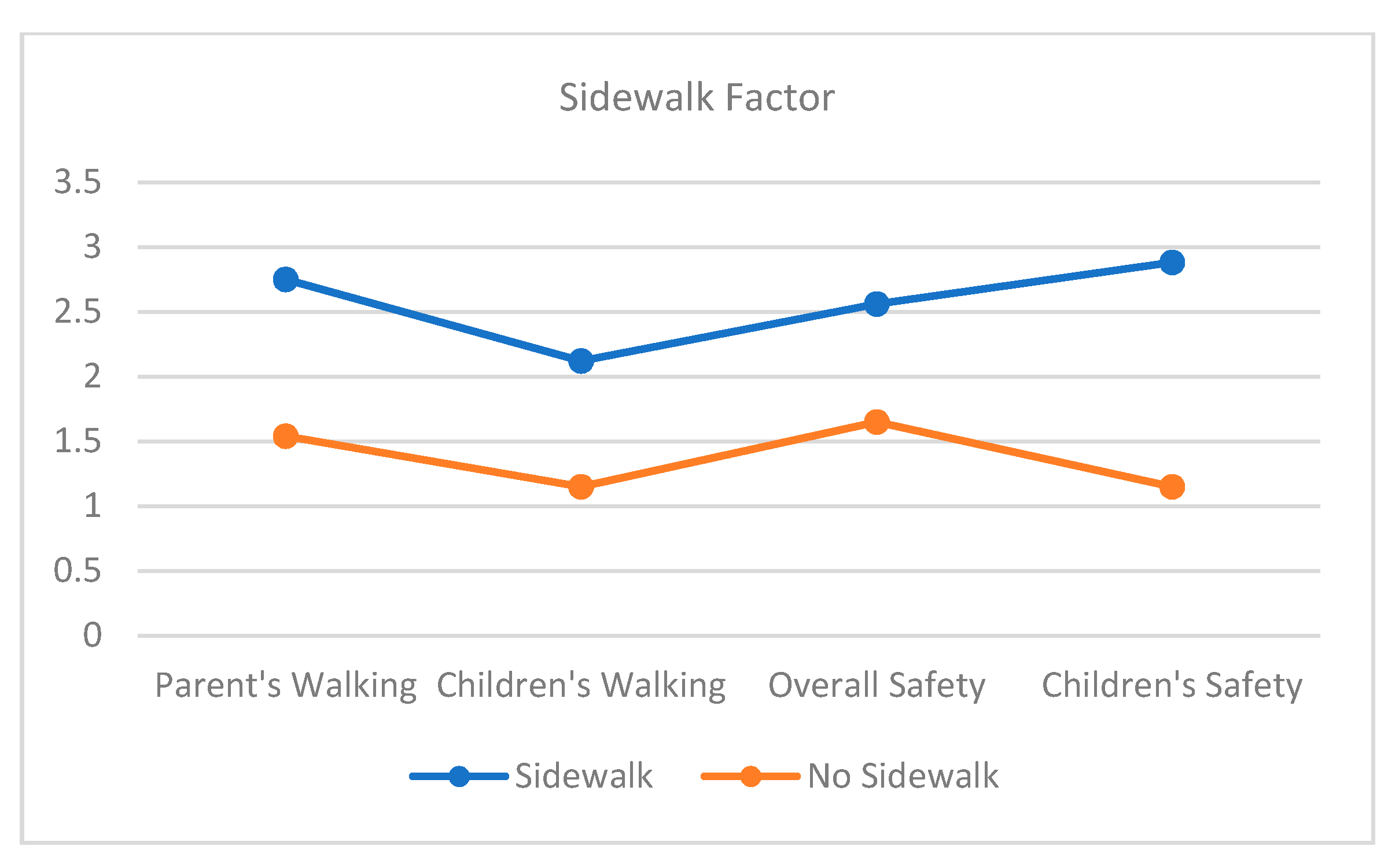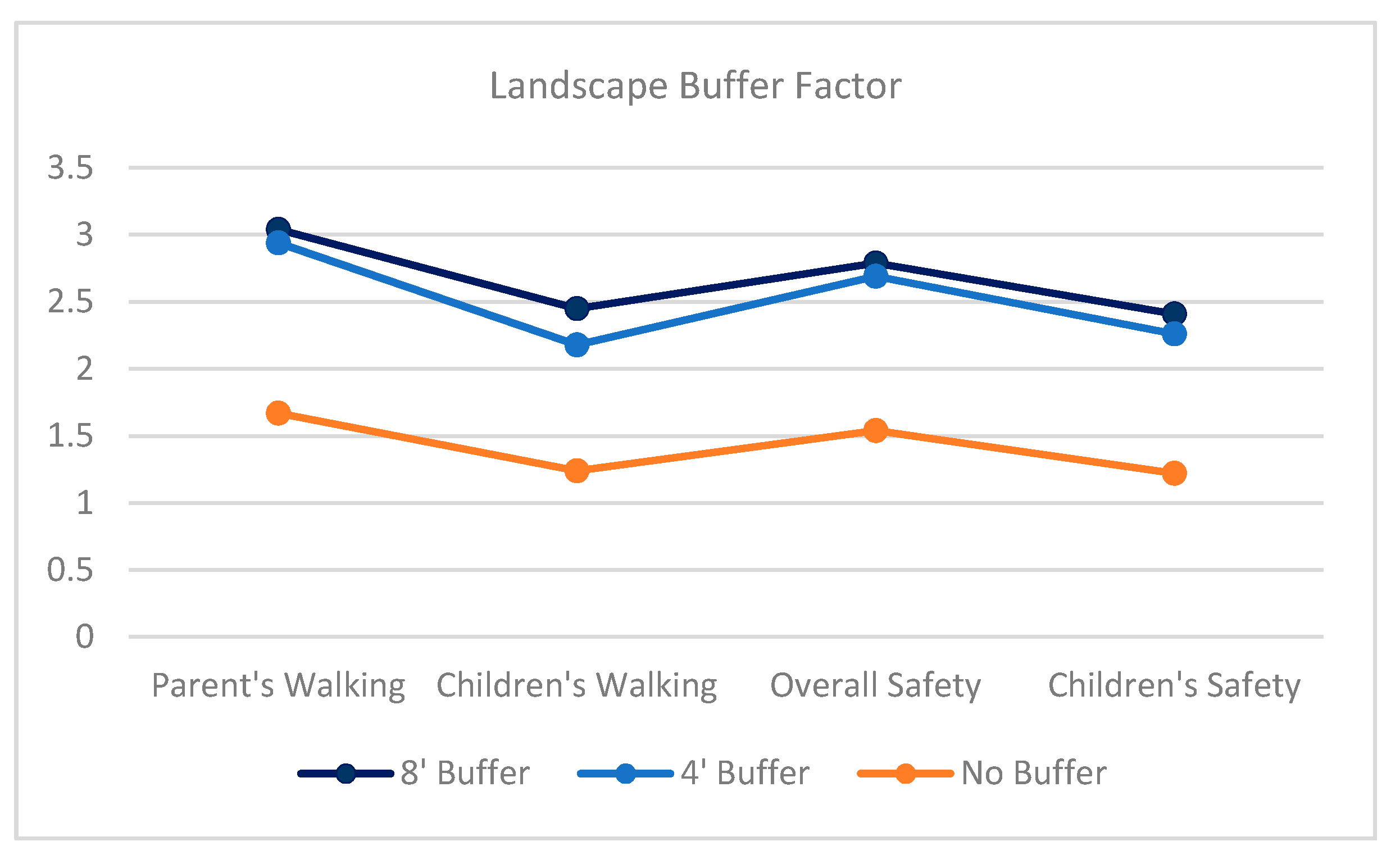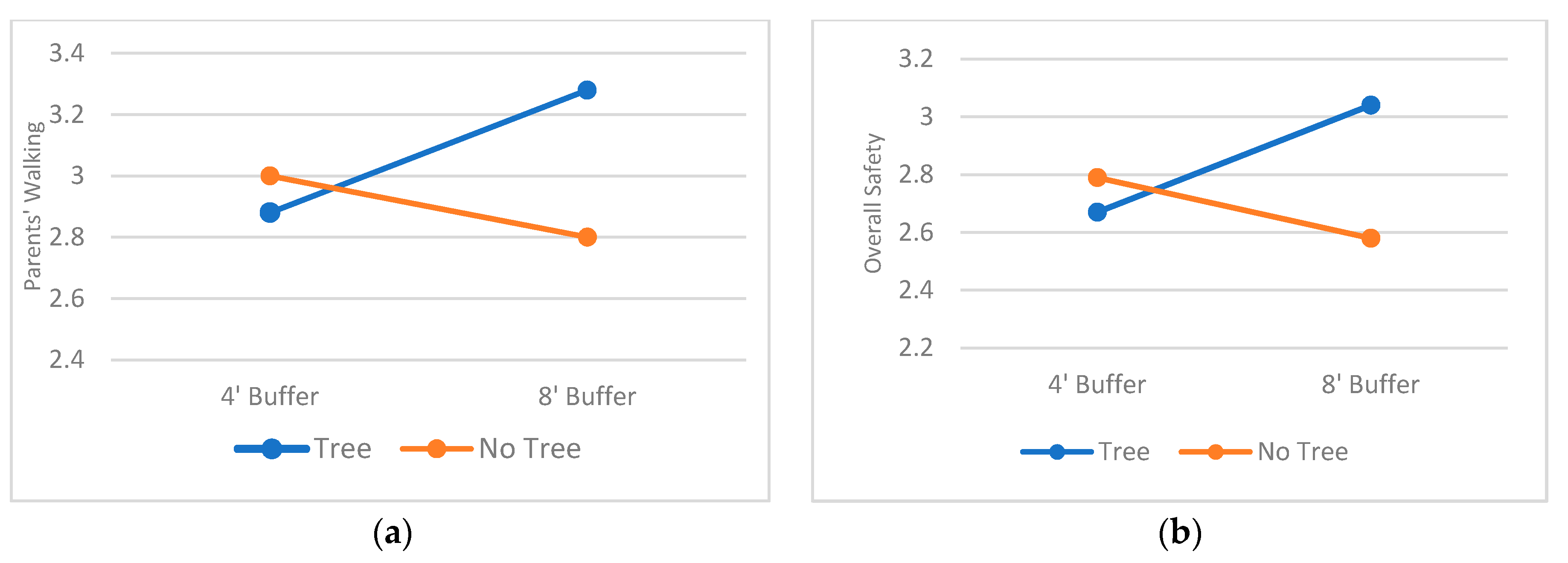The Effects of Pedestrian Environments on Walking Behaviors and Perception of Pedestrian Safety
Abstract
:1. Introduction
- (1)
- Affect parents’ decision to walk themselves and allow their children to walk to school;
- (2)
- Affect parent’s perceptions of pedestrian safety for themselves and their children.
1.1. Research Background
1.1.1. Sidewalks
1.1.2. Landscape Buffers
1.1.3. Trees
2. Materials and Methods
2.1. Research Design
2.2. Participants
2.3. Environmental Conditions
2.4. Research Procedure and Questions
2.4.1. Walkability
- Would you like to walk in this environment?
- Would you be willing to let your children walk in this environment?
2.4.2. Perception of Pedestrian Safety
- What is your sense of the overall safety of the environment you just walked through?
- How safe is this environment for your child to walk to school?
3. Results
3.1. Environmental Conditions (Condition 1 through Condition 6)
3.2. Environmental Factors (Sidewalks, Landscape Buffers, and Street Trees)
3.2.1. Sidewalks
3.2.2. Landscape Buffers
3.2.3. Street Trees
4. Discussion and Conclusions
Author Contributions
Funding
Institutional Review Board Statement
Informed Consent Statement
Data Availability Statement
Conflicts of Interest
References
- Anderson, P.M.; Butcher, K.F.; Schanzenbach, D.W. Understanding recent trends in childhood obesity in the United States. Econ. Hum. Biol. 2019, 34, 16–25. [Google Scholar] [CrossRef] [PubMed]
- Kontou, E.; McDonald, N.C.; Brookshire, K.; Pullen-Seufert, N.C.; LaJeunesse, S.U.S. active school travel in 2017: Prevalence and correlates. Prev. Med. Rep. 2020, 17, 101024. [Google Scholar] [CrossRef] [PubMed]
- Weigand, L. A Review of Literature: The effectiveness of Safe Routes to School and Other Programs to Promote Active Transportation to School; Portland State University: Portland, OR, USA, 2008. [Google Scholar]
- Boarnet, M.G.; Anderson, C.L.; Day, K.; McMillan, T.; Alfonzo, M. Evaluation of the California Safe Routes to School legislation: Urban form changes and children’s active transportation to school. Am. J. Prev. Med. 2005, 28, 134–140. [Google Scholar] [CrossRef] [PubMed]
- Landis, B.W.; Vattikuti, V.R.; Ottenberg, R.M.; McLeod, D.S.; Guttenplan, M. Modeling the Roadside Walking Environment: Pedestrian Level of Service. Transp. Res. Rec. J. Transp. Res. Board 2001, 1773, 82–88. [Google Scholar] [CrossRef]
- USA Department of Transportation, Federal Highway Administration. Pedestrian Facilities Users Guide—Providing Safety and Mobility. Available online: https://www.fhwa.dot.gov/publications/research/safety/01102/01102.pdf (accessed on 28 May 2021).
- Eyler, A.A.; Brownson, R.C.; Bacak, S.J.; Housemann, R.A. The Epidemiology of Walking for Physical Activity in the United States. Med. Sci. Sports Exerc. 2003, 35, 1529–1536. [Google Scholar] [CrossRef] [PubMed] [Green Version]
- Knell, G.; Durand, C.P.; Shuval, K.; Kohl III, H.W.; Salvo, D.; Olyuomi, A.; Gabriel, K.P. If you build, will they come? A quasi-experiment of sidewalk improvements and physical activity. Transl. J. Am. Coll. Sports Med. 2018, 3, 66–67. [Google Scholar] [PubMed]
- McMahon, P.J.; Zegeer, C.V.; Duncan, C.; Knoblauch, R.L.; Stewart, J.R.; Khattak, A.J. An Analysis of Factors Contributing to ‘Walking Along Roadway’ Crashes: Research Study and Guidelines for Sidewalks and Walkways; University of North Carolina Highway Safety Research Center: Chapel Hill, NC, USA, 2002. [Google Scholar]
- USA Department of Transportation, National Highway Traffic Safety Administration. Traffic Safety Facts: 2017 Data. Available online: https://crashstats.nhtsa.dot.gov/Api/Public/ViewPublication/812719 (accessed on 28 June 2021).
- Knoblauch, R.; Tustin, B.; Smith, S.; Pietrucha, M. Investigation of Exposure-Based Pedestrian Accident Areas: Crosswalks, Sidewalks, Local Streets, and Major Arterials; US Department of Transportation: Washington, DC, USA, 1988. [Google Scholar]
- Giles-Corti, B.; Donovan, R.J. The relative influence of individual, social and physical environment determinants of physical activity. Soc. Sci. Med. 2002, 54, 1793–1812. [Google Scholar] [CrossRef]
- Sallis, J.F. Measuring Physical Activity Environments: A Brief History. Am. J. Prev. Med. 2009, 36, S86–S92. [Google Scholar] [CrossRef] [PubMed] [Green Version]
- Cooper, A.R.; Andersen, L.B.; Wedderkopp, N.; Page, A.S.; Froberg, K. Physical Activity Levels of Children Who Walk, Cycle, or Are Driven to School. Am. J. Prev. Med. 2005, 29, 179–184. [Google Scholar] [CrossRef] [PubMed]
- Rosenberg, R.E.; Sallis, J.F.; Conway, T.L.; Cain, K.L.; McKenzie, T.L. Active Transportation to School Over 2 Years in Relation to Weight Status and Physical Activity. Obesity 2006, 14, 1771–1776. [Google Scholar] [CrossRef] [PubMed]
- Mendoza, J.; Watson, K.; Nguyen, N.; Cerin, E.; Baranowski, T.; Nicklas, T.A. Active Commuting to School and Association with Physical Activity and Adiposity Among US Youth. J. Phys. Act. Health 2011, 8, 488–495. [Google Scholar] [CrossRef] [PubMed]
- Sirard, J.R.; Riner, W.F.; McIver, K.L.; Pate, R.R. Physical Activity and Active Commuting to Elementary School. Med. Sci. Sports Exerc. 2005, 37, 2062–2069. [Google Scholar] [CrossRef] [PubMed]
- Nabors, D.; Schneider, R.; Leven, D.; Lieberman, K.; Mitchell, C. Chapter 3: Actions to Increase the Safety of Pedestrian Accessing Transit. Pedestrian Safety Guide for Transit Agencies; Federal Highway Administration: Washington, DC, USA, 2008; pp. 24–48. Available online: https://safety.fhwa.dot.gov/ped_bike/ped_transit/ped_transguide/transit_guide.pdf (accessed on 23 May 2021).
- Texas Department of Transportation. Landscape and Aesthetics Design Manual. Available online: http://onlinemanuals.txdot.gov/txdotmanuals/lad/lad_mn.htm (accessed on 12 May 2021).
- Velarde, M.; Fry, G.; Tveit, M. Health effects of viewing landscapes—Landscape types in environmental psychology. Urban. For. Urban. Green. 2007, 6, 199–212. [Google Scholar] [CrossRef]
- Opdam, P. Implementing human health as a landscape service in collaborative landscape approaches. Landsc. Urban. Plan. 2020, 199, 103819. [Google Scholar] [CrossRef]
- Chen, Y.; Liu, T.; Xie, X.; Marušić, B.G. What Attracts People to Visit Community Open Spaces? A Case Study of the Overseas Chinese Town Community in Shenzhen, China. Int. J. Environ. Res. Public Health 2016, 13, 644. [Google Scholar] [CrossRef] [PubMed] [Green Version]
- Giles-Corti, B.; Donovan, R.J. Relative Influences of Individual, Social Environmental, and Physical Environmental Correlates of Walking. Am. J. Public Health 2003, 93, 1583–1589. [Google Scholar] [CrossRef] [PubMed]
- Maghelal, P.; Natesan, P.; Rosenblatt-Naderi, J.; Kweon, B. Investigating the use of virtual reality for pedestrian environment. J. Archit. Plan. Res. 2011, 28, 104–117. [Google Scholar]
- Appleton, J. The Expereince of Landscape; John Wiley & Sons: New York, NY, USA, 1996. [Google Scholar]
- Marans, R.W.; Stokols, D. (Eds.) Environmental Simulation: Research and Policy Issues; Plenum Press: New York, NY, USA, 1993. [Google Scholar] [CrossRef]
- Caffò, A.O.; Tinella, L.; Lopez, A.; Spano, G.; Massaro, Y.; Lisi, A.; Stasolla, F.; Catanesi, R.; Nardulli, F.; Grattagliano, I.; et al. The Drives for Driving Simulation: A Scientometric Analysis and a Selective Review of Reviews on Simulated Driving Research. Front. Psychol. 2020, 11, 917. [Google Scholar] [CrossRef] [PubMed]
- Rosenblatt Naderi, J. On the Nature of Walking and Learning Pedestrian Environments. ARCC Conference Repository 2019, 1. Available online: https://www.arcc-journal.org/index.php/repository/article/view/792 (accessed on 22 July 2021).




| Condition 1 | Condition 2 | Condition 3 | Condition 4 | Condition 5 | Condition 6 | |
|---|---|---|---|---|---|---|
| Sidewalks | No | Yes | Yes | Yes | Yes | Yes |
| Landscape Buffer | No | No | 4 feet | 8 feet | 4 feet | 8 feet |
| Street Trees | No | No | No | No | Yes | Yes |
| Conditions | Simulations | Actual Environments |
|---|---|---|
| 1 |  |  |
| 2 |  |  |
| 3 |  |  |
| 4 |  |  |
| 5 |  |  |
| 6 |  |  |
| Condition 1 Mean (SD) | Condition 2 Mean (SD) | Condition 3 Mean (SD) | Condition 4 Mean (SD) | Condition 5 Mean (SD) | Condition 6 Mean (SD) | Grand Mean (SD) | |
|---|---|---|---|---|---|---|---|
| Sidewalk | No | Yes | Yes | Yes | Yes | Yes | |
| Landscape Buffer | No | No | 4 feet | 8 feet | 4 feet | 8 feet | |
| Street Trees | No | No | No | No | Yes | Yes | |
| Parents’ Walking | 1.54 (0.76) | 1.81 (0.85) | 3.00 (0.69) | 2.81 (0.80) | 2.88 (0.77) | 3.28 (0.61) | 2.55 (0.49) |
| Children’s Walking | 1.15 (0.37) | 1.33 (0.60) | 2.19 (0.72) | 2.29 (0.84) | 2.17 (0.76) | 2.60 (0.78) | 1.97 (0.47) |
| Overall Safety | 1.40 (0.58) | 1.65 (0.63) | 2.76 (0.60) | 2.52 (0.82) | 2.65 (0.75) | 3.04 (0.72) | 2.34 (0.48) |
| Children’s Safety | 1.15 (0.37) | 1.25 (0.48) | 2.28 (0.77) | 2.31 (0.75) | 2.23 (0.86) | 2.52 (0.78) | 1.96 (0.47) |
| Between Subjects | Within Subjects | Interaction | ||||||||||
|---|---|---|---|---|---|---|---|---|---|---|---|---|
| Order (O) | Pedestrian Environments (PE) | O × PE | ||||||||||
| SS | df | MS | F | SS | df | MS | F | SS | df | MS | F | |
| Parents’ Walking | 10.63 | 5 | 2.13 | 1.68 | 62.64 | 5 | 12.53 | 35.63 *** | 12.41 | 25 | 0.50 | 1.41 |
| Children’s Walking | 6.89 | 5 | 1.38 | 1.09 | 41.53 | 5 | 8.31 | 25.18 *** | 6.51 | 25 | 0.26 | 0.79 |
| Overall Safety | 5.72 | 5 | 1.15 | 0.90 | 43.47 | 5 | 8.69 | 29.61 *** | 10.91 | 25 | 0.44 | 1.49 |
| Children’s Safety | 6.99 | 5 | 1.40 | 1.40 | 44.64 | 5 | 8.93 | 24.47 *** | 8.34 | 25 | 0.33 | 0.92 |
| Conditions | Conditions | Mean Difference | |||
|---|---|---|---|---|---|
| Parent’s Walking | Children’s Walking | Overall Safety | Children’s Safety | ||
| 1 | 3 | −1.52 *** | −1.04 *** | −1.35 *** | −1.13 *** |
| 4 | −1.32 *** | −1.14 *** | −1.13 *** | −1.16 *** | |
| 5 | −1.40 *** | −1.02 *** | −1.22 *** | −1.08 *** | |
| 6 | −1.80 *** | −1.48 *** | −1.57 *** | −1.38 *** | |
| 2 | 3 | −1.24 *** | −0.86 *** | −1.09 *** | −1.00 *** |
| 4 | −1.04 *** | −0.96 *** | −0.87 *** | −1.03 *** | |
| 5 | −1.12 *** | −0.84 *** | −0.96 *** | −0.95 *** | |
| 6 | −1.52 *** | −1.3 *** | −1.30 *** | −1.25 *** | |
| 6 | 3 | ns | 0.44 * | ns | ns |
| 6 | 4 | 0.48 ** | 0.34 * | 0.44 ** | ns |
| 6 | 5 | 0.40 ** | 0.46 ** | 0.35 ** | 0.14 * |
| Sidewalks | ||||
|---|---|---|---|---|
| SS | df | F | ηp2 | |
| Parents’ Walking | 19.20 | 1 | 72.33 *** | 0.74 |
| Children’s Walking | 12.07 | 1 | 135.96 *** | 0.85 |
| Overall Safety | 16.53 | 1 | 147.35 *** | 0.86 |
| Children’s Safety | 38.71 | 1 | 149.04 *** | 0.86 |
| Landscape Buffers | |||||
|---|---|---|---|---|---|
| SS | df | MS | F | ηp2 | |
| Parents’ Walking | 30.20 | 2 | 15.10 | 78.36 *** | 0.76 |
| Children’s Walking | 21.05 | 2 | 10.52 | 54.92 *** | 0.69 |
| Overall Safety | 25.16 | 2 | 12.58 | 61.83 *** | 0.71 |
| Children’s Safety | 21.95 | 2 | 10.97 | 59.30 *** | 0.70 |
| Main Effects | Interaction | |||||||||||
|---|---|---|---|---|---|---|---|---|---|---|---|---|
| Buffer Widths (BW) | Street Trees (ST) | BW × ST | ||||||||||
| SS | df | F | ηp2 | SS | df | F | ηp2 | SS | df | F | ηp2 | |
| Parents’ Walking | 0.81 | 1 | 1.63 | 0.06 | 0.25 | 1 | 0.80 | 0.03 | 2.25 | 1 | 21.6 *** | 0.47 |
| Children’s Walking | 0.64 | 1 | 1.84 | 0.07 | 1.96 | 1 | 3.91 | 0.14 | 0.81 | 1 | 3.94 | 0.14 |
| Overall Safety | 0.67 | 1 | 1.96 | 0.08 | 0.17 | 1 | 0.61 | 0.03 | 2.04 | 1 | 10.53 ** | 0.31 |
| Children’s Safety | 0.17 | 1 | 0.31 | 0.01 | 0.64 | 1 | 3.38 | 0.12 | 0.45 | 1 | 1.46 | 0.06 |
| Street Trees | ||||
|---|---|---|---|---|
| SS | df | F | ηp2 | |
| Parents’ Walking | 8.08 | 1 | 48.47 *** | 0.66 |
| Children’s Walking | 5.56 | 1 | 45.30 *** | 0.64 |
| Overall’ Safety | 7.89 | 1 | 49.99 *** | 0.67 |
| Children’s Safety | 9.66 | 1 | 19.21 *** | 0.43 |
Publisher’s Note: MDPI stays neutral with regard to jurisdictional claims in published maps and institutional affiliations. |
© 2021 by the authors. Licensee MDPI, Basel, Switzerland. This article is an open access article distributed under the terms and conditions of the Creative Commons Attribution (CC BY) license (https://creativecommons.org/licenses/by/4.0/).
Share and Cite
Kweon, B.-S.; Rosenblatt-Naderi, J.; Ellis, C.D.; Shin, W.-H.; Danies, B.H. The Effects of Pedestrian Environments on Walking Behaviors and Perception of Pedestrian Safety. Sustainability 2021, 13, 8728. https://0-doi-org.brum.beds.ac.uk/10.3390/su13168728
Kweon B-S, Rosenblatt-Naderi J, Ellis CD, Shin W-H, Danies BH. The Effects of Pedestrian Environments on Walking Behaviors and Perception of Pedestrian Safety. Sustainability. 2021; 13(16):8728. https://0-doi-org.brum.beds.ac.uk/10.3390/su13168728
Chicago/Turabian StyleKweon, Byoung-Suk, Jody Rosenblatt-Naderi, Christopher D. Ellis, Woo-Hwa Shin, and Blair H. Danies. 2021. "The Effects of Pedestrian Environments on Walking Behaviors and Perception of Pedestrian Safety" Sustainability 13, no. 16: 8728. https://0-doi-org.brum.beds.ac.uk/10.3390/su13168728





